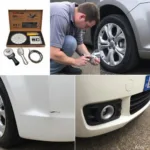You slide into your car, eager to start your day, but as you settle into the driver’s seat, a familiar squeak erupts from the back. It’s the dreaded rear seat squab, reminding you of its less-than-perfect condition. Before you resign yourself to enduring the symphony of squeaks, know this: a car rear seat squab can often be repaired.
Understanding the Squeaky Culprit: Your Car’s Rear Seat Squab
The “squab” is the technical term for the cushioned part of a seat, specifically where your back rests. In the context of your car’s rear seat, it’s the part that often takes the brunt of passengers, cargo, and general wear and tear.
Why is your rear seat squeaking? It’s likely due to one or a combination of these culprits:
- Worn-Out Padding: Over time, the foam padding inside the squab can break down and lose its ability to cushion and dampen movement, leading to friction and noise.
- Broken or Damaged Springs: The springs within the squab provide support and flexibility. If they become broken or damaged, they can rub against each other or the frame, causing squeaking.
- Loose or Worn-Out Fasteners: The squab is attached to the seat frame with bolts, screws, or clips. If these become loose or worn, they can create movement and noise.
- Friction Between Materials: Even the upholstery fabric itself can become a source of squeaking, especially if it rubs against the frame or other parts of the seat.
DIY or Seek Professional Help?
Deciding whether to tackle the repair yourself or seek a professional depends on your comfort level with DIY projects and the complexity of the issue.
You can likely handle these repairs at home:
- Tightening Loose Fasteners: Inspect the seat for any visible bolts or screws and tighten them carefully.
- Addressing Minor Upholstery Issues: If the fabric is loose or there’s a small tear, you can often repair it with fabric glue or a simple stitch.
- Adding Lubrication: A silicone-based lubricant can quiet squeaks caused by friction between metal parts or the upholstery rubbing against the frame.
For more complex repairs, consider a professional:
- Replacing Damaged Padding or Springs: This often requires removing the upholstery and working with specialized tools.
- Repairing Broken Frames or Structural Damage: These repairs demand expertise to ensure the seat’s structural integrity and safety.
Cost of Car Rear Seat Squab Repair
While the cost varies depending on the severity of the damage, the type of vehicle, and labor rates in your area, here’s a general estimate:
- DIY Repairs: $10 – $50 (for basic materials like lubricant, fasteners, or fabric glue).
- Professional Repairs: $100 – $500+ (depending on the extent of the damage and whether upholstery replacement is needed).
Prolonging the Life of Your Car’s Seats
A little prevention can go a long way in keeping your car seats squeak-free:
- Regular Cleaning: Vacuum your car seats regularly to remove dirt and debris that can contribute to wear and tear.
- Use Protective Covers: Seat covers can help protect your upholstery from spills, stains, and UV damage.
- Distribute Weight Evenly: Avoid placing heavy objects consistently on one area of the seat.
- Address Issues Promptly: Don’t ignore squeaks or minor damage. Early intervention is often simpler and less costly.
Conclusion
Don’t let a squeaky car rear seat squab drive you crazy. By understanding the potential causes and repair options, you can make an informed decision about whether to tackle the fix yourself or seek professional help. With a little effort, you can restore peace and quiet to your daily commute.

